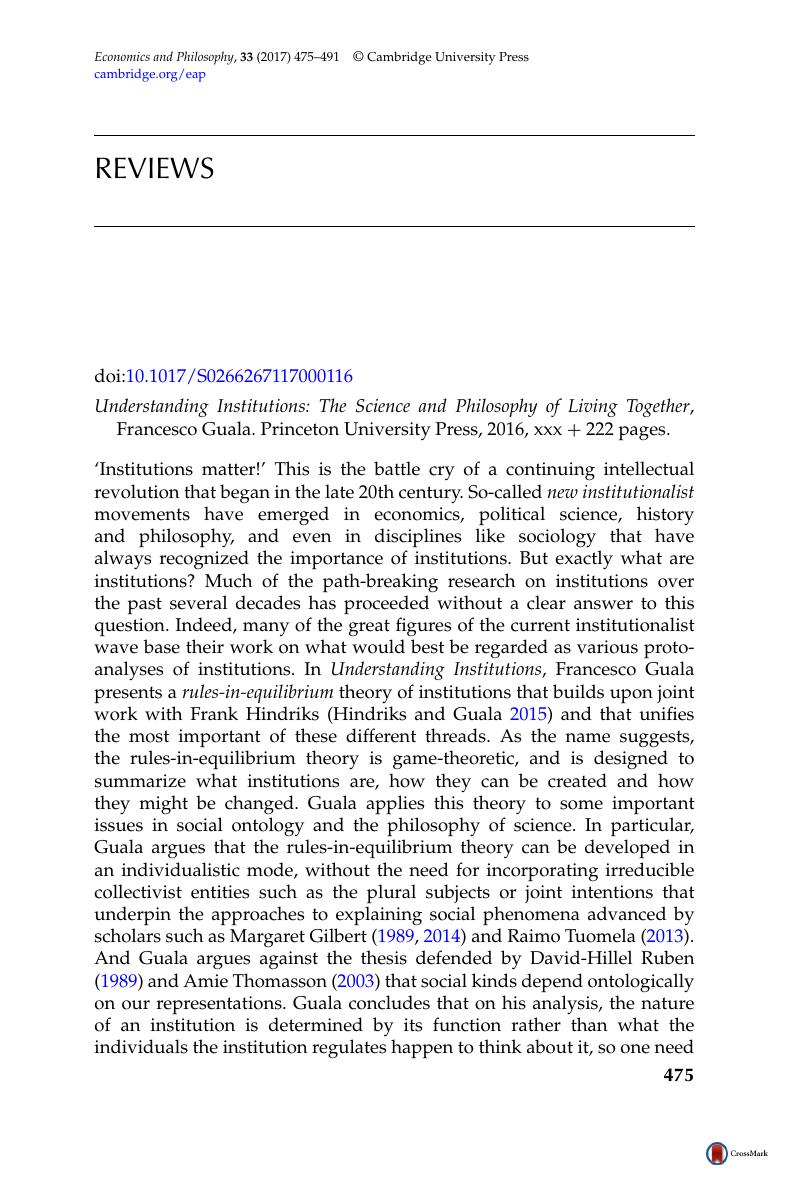No CrossRef data available.
Article contents
Understanding Institutions: The Science and Philosophy of Living Together, Francesco Guala . Princeton University Press, 2016, xxx + 222 pages.
Published online by Cambridge University Press: 21 June 2017
Abstract
An abstract is not available for this content so a preview has been provided. Please use the Get access link above for information on how to access this content.

- Type
- Reviews
- Information
- Copyright
- Copyright © Cambridge University Press 2017
References
REFERENCES
Aumann, R.
1974. Subjectivity and correlation in randomized strategies. Journal of Mathematical Economics
1: 67–96.CrossRefGoogle Scholar
Aumann, R.
1987. Correlated equilibrium as an expression of Bayesian rationality. Econometrica
55: 1–18.CrossRefGoogle Scholar
Gilbert, M.
2014. Joint Commitment: How We Make the Social World. New York, NY: Oxford University Press.Google Scholar
Hindriks, F. and Guala, F.. 2015. Institutions, rules and equilibria: a unified theory. Journal of Institutional Economics
11: 459–580.CrossRefGoogle Scholar
Lewis, D.
1969. Convention: A Philosophical Study. Cambridge, MA: Harvard University Press.Google Scholar
Miller, S.
2014. Social institutions. Stanford Encyclopedia of Philosophy, ed. Zalta, E.N.. https://plato.stanford.edu/archives/win2014/entries/social-institutions/.Google Scholar
North, D.
1990. Institutions, Institutional Change and Economic Performance. Cambridge: Cambridge University Press.CrossRefGoogle Scholar
Ruben, D.-H.
1989. Realism in the social sciences. In Dismantling Truth, ed. Lawson, H. and Appignanesi, L., 58–75. London: Weidenfeld and Nicolson.Google Scholar
Schotter, A.
1981. The Economic Theory of Social Institutions. Cambridge: Cambridge University Press.CrossRefGoogle Scholar
Searle, J.R.
1995. The Construction of Social Reality. New York, NY: Simon and Schuster.Google Scholar
Searle, J.R.
2015. Status functions and institutional facts: reply to Hendriks and Guala. Journal of Institutional Economics
11: 507–514.CrossRefGoogle Scholar
Tadelis, R.
2013. Game Theory: An Introduction. Princeton, NJ: Princeton University Press.Google Scholar
Thomasson, A.
2003. Realism and human kinds. Philosophy and Phenomenological Research
68: 580–609.CrossRefGoogle Scholar
Tuomela, R.
2013. Social Ontology: Collective Intentionality and Group Agents. New York, NY: Oxford University Press.CrossRefGoogle Scholar
Vanderschraaf, P.
1998. Knowledge, equilibrium and convention. Erkenntnis
49, 337–369.CrossRefGoogle Scholar





